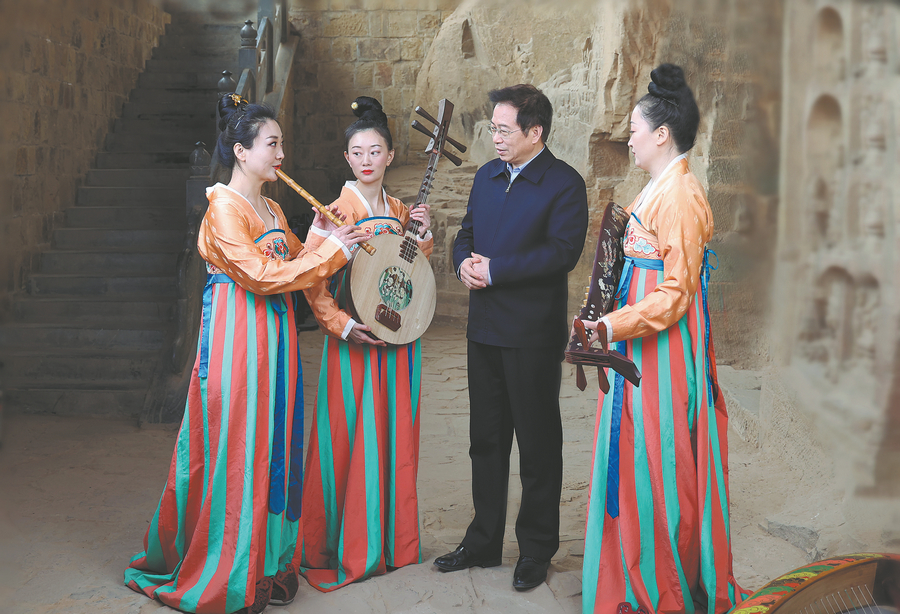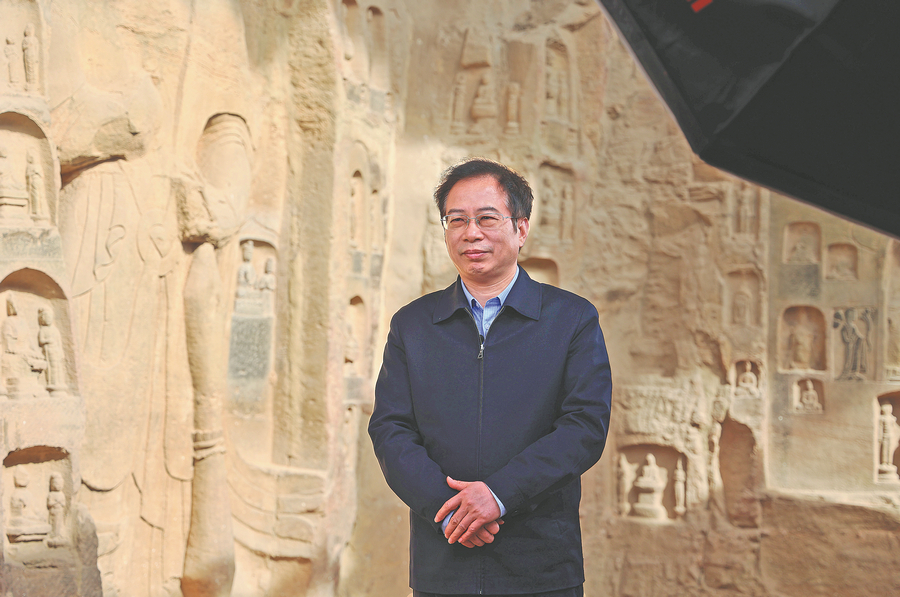
Delicately digging away layer by layer with the "archaeological artifact" Luoyang shovel (an archaeological tool), and brushing away dust, an unknown "treasure" is slowly revealed. It could be a miniature replica of an ancient marvel like a bronze tiger tally, a rabbit-head seal, a bronze Buddha, or even silver plaque.
Uncovering the past has never been more exciting. Thanks to the Henan Museum's innovative archaeological blind box (firstly introduced in 2019), enthusiasts can experience the thrill of discovery firsthand.
But this is just the beginning of the museum's renaissance. From captivating cultural products to collaborations with popular TV shows like National Treasure and Wonderful Night of the Lantern Festival, Henan Museum is making waves in the world of cultural innovation.
With 2.7 million visitors and over 39 million yuan ($5.4 million) in revenue from cultural products last year, the museum is not just preserving history, it is shaping the future of cultural exploration.
Ma Xiaolin, director of the Henan Museum and member of the Chinese People's Political Consultative Conference National Committee, emphasizes the importance of bringing history to life. He believes that static displays aren't enough and that instead, innovative ways of making artifacts and exhibitions more engaging and dynamic are needed.
"By finding the intersection between traditional culture and modern life, even ancient relics can become trendy and win fans," he says.
The Henan Museum has been a pioneer in this direction, making use of a variety of approaches including exhibitions, educational programs, digital outreach, and cultural product development.
Ma says that over the past year, significant progress has been made in the use and promotion of artifacts around the country.
For instance, the understanding of the origins of Chinese civilization has deepened. Thanks to major archaeological discoveries and research results, numerous exhibitions and initiatives have promoted the creative transformation of traditional Chinese culture, resulting in the development of a wide range of cultural and creative products.
As the two sessions unfolds, Ma continues in his role as a member of the 13th and 14th Chinese People's Political Consultative Conference National Committee. Since 2018, he's been advocating for cultural heritage preservation, with the aim of bolstering both the protection and the use of cultural relics.
This year, he presents several proposals, including ones to establish a coordinated compensation mechanism for heritage protection and archaeological site parks, and another to tackle the challenge of disseminating Chinese culture internationally in the social media era.
Ma stresses the vital need to protect cultural relics, and sees this as a long-term task that demands continuous dedication. He says that people should cherish cultural heritage as much as they do their own lives, to keep its brilliance alive.
He also highlights the significance of leveraging social media to enhance the international influence of Chinese culture. He views museums as vital components in China's modern public cultural service system. "Museums play a crucial role in preserving and passing on human civilization, especially in promoting the rich heritage of Chinese culture, and its interaction with other civilizations," Ma says.

Major star
Established in 1927, the Henan Museum is one of the country's oldest modern museums. In 2009, it was chosen to be one of the first national-level museums jointly created by the central and local governments. With a collection of over 170,000 artifacts, it houses a diverse range of treasures, notably prehistoric relics, bronze ware from the Shang Dynasty (c. 16th century-11th century BC) and the Zhou Dynasty (c. 11th century-256 BC), ceramics from various dynasties, jade artifacts, and stone carvings.
Ma encourages tourists visiting Henan to take the time to explore the museum.
"It's a cultural and artistic treasure trove that pays witness to the development of Chinese civilization and showcases the historical evolution of the country," he says. "It's an important window on appreciating the culture of the Central Plains, the Yellow River, and Chinese civilization."
To entice more visitors, Ma recommends a visit to one of the museum's nine treasures — the Lotus and Crane Square Pot.
Unearthed in 1923 in Xinzheng, Henan, the pot is a significant bronze artifact from the Spring and Autumn Period (770-476 BC). Standing 117 centimeters tall and weighing around 65 kilograms, its square-shaped body is adorned with two mythical dragon-like creatures on each side of its neck, with four winged dragons crawling upward around its belly.
"The most spectacular part is the lid, which is adorned with blooming lotus petals and a crane standing in the center, symbolizing the spirit of our time," he adds.
The Lost Treasures archaeological blind box cultural products, which have become a sensation, demonstrate the museum's commitment to blending culture and tourism.
"We merged archaeology with the blind box concept to create these products in order to deepen the public understanding of modern excavation and restoration," Ma explains.
"We've designed them to recreate the experience of excavation and restoration, which allows participants to discover hidden details," he adds.
"The boxes quickly became popular, and became hard to find. Some visitors even choose to stay nearby just for a chance to purchase one," says Ma. He says that the museum began developing cultural products seriously in 2019. Over the years, its range has grown from 100 to over 1,500 items.
"We prioritize social impact over profit. The products are a crucial part of cultural outreach and an extension of our collections," Ma adds.
In recent years, the Henan Museum has pursued an international strategy, promoting cultural exchanges and cooperation.
It has organized exhibitions and academic exchanges in countries like the United States, the United Kingdom, France, and Japan. Its cultural products have been displayed in prestigious venues, including New York's Fifth Avenue.
As a member of the International Council of Museums, it collaborates on museum security and through international events and partnerships, continues to foster global cultural dialogue and exchange, Ma says.
New year, new approach
The director says that this year, the Henan Museum is increasing efforts to protect cultural relics by implementing a "technology +" strategy that blends technology with cultural preservation and will build a modern research center for protection that's both smart and effective.
"We plan to host over 40 exhibitions this year, including ones that showcase folkloric treasures, Han portraits, and ancient inscriptions, in addition to collaborative exhibitions with other museums in the province," he says.
The museum will also continue cultural exchanges by hosting exhibitions like Between Heaven and Earth in Hong Kong, and Dialogue between the Chinese and Arab Civilizations in the United Arab Emirates.
On the educational front, they're expanding their outreach with over 1,000 offline educational activities and are also strengthening partnerships with schools to offer engaging programs, such as tours focusing on ancient capitals and cultural heritage sites, he adds.
On March 1, the Henan Museum and Xuchang city, Henan province, joined forces in a significant move. The Xuchang City Museum officially became the Henan Museum Xuchang Branch. The collaboration strengthens efforts to preserve cultural heritage, plan exhibitions, and develop cultural products.
As part of this partnership, items from the museum's popular "Encounter with Henan" cultural brand are available in Xuchang. Now, visitors to the Xuchang City Museum can purchase a variety of cultural products such as the blind box series, Jun porcelain figures, figurines of ancient women musicians, plush toys, and stationery.
"In future, the Henan Museum will also set up branches in county-level museums," Ma says. The initiative is an effort by the museum to support smaller museums, foster mutual development and enhance the integration of culture and tourism.
"In the new year, the Henan Museum will focus on creating a world-class museum with Chinese characteristics, continue to come up with innovative exhibition methods to make artifacts more vivid and accessible, and enhance the influence of Chinese civilization (through more international exchanges). We aim to better integrate the achievements of cultural relic protection and their utilization into daily life and serve the people," he says.


